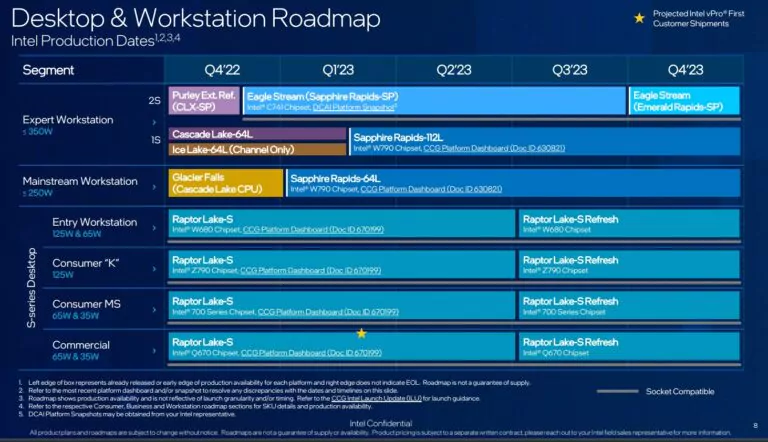It is anticipated that the clock speeds of Intel’s 14th Gen Raptor Lake Refresh desktop CPUs will increase even more in comparison to 13th Gen Raptor Lake chips. According to Moore’s Law is Dead, the 14th Gen Raptor Lake Refresh desktop CPU family from Intel will be supported by current LGA 1700 platforms and is anticipated to debut in the third quarter of 2023. The lineup will sit alongside the Meteor Lake-P and Meteor Lake-M families and will be available in desktop “S” and mobility “HX” variations.
The Intel Raptor Lake Refresh Desktop CPU family, according to the rumour, won’t have any configurations with more cores than 8+16, but it is anticipated to include some new SKUs, primarily a 6+8 and a 2+8 SKU configuration that can be marketed as a Core i5 and Core i3 tier design. These could be internal test models or they could be real launch SKUs.
The fastest Intel 14th Gen Raptor Lake Refresh CPU is rumoured to boost up to 6.2 GHz, and an even faster-binned version that clocks up to 6.5 GHz is also possible.

This 6.2 GHz clock speed represents an increase of 7% over the Core i9-13900K’s peak frequency of 5.8 GHz and a 3% over the 13900KS’s peak frequency of 6.0 GHz.
It is unclear if this chip has a special “KS” edition or if it is the standard component with TB 3.0 frequency. The increased frequency might enable Intel to compete with AMD’s Ryzen 7000X3D chips, but at the expense of significantly increased power.
According to some rumours, the lineup may provide a further improvement in multi-threading performance and make use of even very large cache pools. There has been no official confirmation of the DLVR (Digital Voltage Regulator) being housed within the Raptor Lake Refresh chips, which were anticipated for the non-refresh family.
All consumer and entry-level workstation platforms with 35W, 65W, and 125W SKUs will be part of the lineup. We now know that Intel’s Raptor Lake refresh will only serve as a stopgap measure until the true next-generation components appear, much like Emerald Rapids-SP (Xeon platform).
Also Read:







